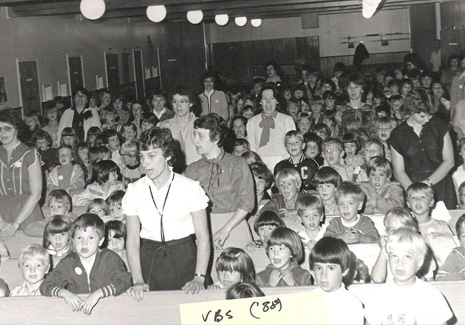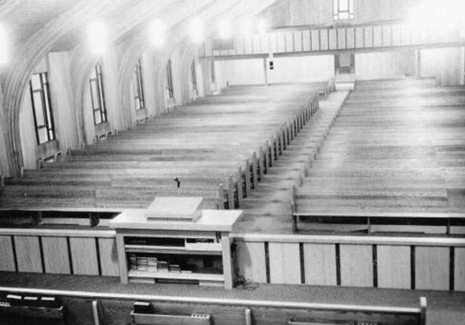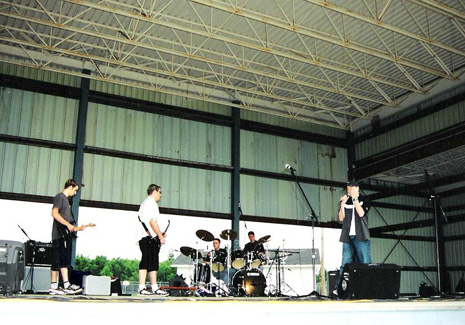(NB: Most of this report was prepared by David Jeans - August 1995)
 A time of celebration is a time of reflection. The new building at Windsor is built on a foundation of prayers, tears and labour extending back over a period of almost seventy years. It is the fruition of the work of many, both pastors and laity, that have made the Windsor Pentecostal Church the flagship of the Pentecostal Assemblies of Newfoundland. It is a time to recognize and honour them.
A time of celebration is a time of reflection. The new building at Windsor is built on a foundation of prayers, tears and labour extending back over a period of almost seventy years. It is the fruition of the work of many, both pastors and laity, that have made the Windsor Pentecostal Church the flagship of the Pentecostal Assemblies of Newfoundland. It is a time to recognize and honour them.
During the mid 1920's, an employment boom occurred in central Nfld. on the northwest bank of the Exploits River. The Anglo-Newfoundland Development Company had built a paper mill and the supporting structures of roads, schools and health facilities. The resulting company town of Grand Falls was progressive, prosperous and modern.
Seasonal workers who came from various communities to work with the Company at Grand Falls erected small shacks across the tracks at Grand Falls Station so that they could care for themselves and not have to stay in boarding houses.(1)
Many later brought their families creating a twin town that lacked the planning, facilities and respect of its Company-subsidized neighbour. Thus Grand Falls Station was born and grew quickly, although somewhat haphazardly, in the shadow of Grand Falls. In 1937 Grand Falls Station was renamed Windsor by its new Municipal Council, one of the first to be created in Newfoundland. On January 1, 1991, the towns of Windsor and Grand Falls amalgamated and became known as Grand Falls-Windsor.
In 1926, Charles L. March and Lewis Eddy, Corner Brook businessmen, decided to erect a Pentecostal Church at Grand Falls Station. They shipped a car load of lumber by train for this purpose. At about the same time, several young men from Corner Brook, "With a few facts and full of fire,"(2) set out with missionary zeal on a trek to spread the Pentecostal message throughout Newfoundland. William Gillett, Arthur S. Winsor, and Thomas P. Mitchell left Deer Lake to come to Grand Falls Station by train. During the middle of July, Pastor Winsor conducted the first Pentecostal services in a vacant store on Bond Street, owned by a local merchant, William Anderson. The missionary trio stayed long enough to hold several meetings and carry the carload of lumber on their backs from the train station to King Street. They then went by train to Badger and set out on the 35-mile walk to South Brook.
They left behind them the seeds of the gospel and the lumber for the first Pentecostal Church building. The "Cripple-Back" Church, as it was called, built on King Street, was described by Pastor A.S. Bursey in his book, Life's Work Complete:(3)
The building was crude by today's standards. At times during the spring thaw, the water could be seen running halfway up the floor. Erected below street level, the building had a Canadian barn roof of cripple-back structure. A stove, sitting in the centre of the building, was heated by coal from the bin in the porch at the entrance. A partition ran through one end, making the living quarters for the resident pastor, and providing one bedroom, a living-room and a small room leading to the main building. There was a large loft over the kitchen. This was used at one time for a press-room. I believe Good Tidings, the official publication of the Pentecostal Assemblies of Newfoundland, was printed from there for awhile.
The first resident Pentecostal pastors were Miss Gwendolyn White, who later married Newman LaShana and went to be a missionary in India, and Miss Sadie Eddy, who later married Pastor Philip G. Butt.(4) Pastor A.S. Winsor returned two years later to minister in a well-established church.
 By the early 1940's, under the ministry of Pastor A.S. Bursey, the church had outgrown its facilities.(5) Finances were scarce, bank loans were out of the question, but enthusiasm was high. The only building lot available was a swamp across King Street from the "Cripple-Back" Church. It was bought, and a building, large by the standards of those days, was built. This second Pentecostal Church in Windsor, seating at least 400 people, was practically debt free when completed. The "swamp" proved to be the right spot. Adjoining land was purchased for parking and for the erection of a parsonage, an elementary school and a two-room high school.(6) This area of town also became the site for two future churches and the second parsonage.
By the early 1940's, under the ministry of Pastor A.S. Bursey, the church had outgrown its facilities.(5) Finances were scarce, bank loans were out of the question, but enthusiasm was high. The only building lot available was a swamp across King Street from the "Cripple-Back" Church. It was bought, and a building, large by the standards of those days, was built. This second Pentecostal Church in Windsor, seating at least 400 people, was practically debt free when completed. The "swamp" proved to be the right spot. Adjoining land was purchased for parking and for the erection of a parsonage, an elementary school and a two-room high school.(6) This area of town also became the site for two future churches and the second parsonage.
It soon became obvious that this second church building was not large enough. A balcony was added, but it, too, was filled on Sunday evenings. Pastor Bursey wrote how he "feared it might collapse from the weight of the people."(7) A large piece of land adjacent to the Trans Canada Highway was available for a new building, but the congregation decided to remain in Windsor. The third church was constructed on King Street and its parking lot was built where the old building stood.
The Windsor Assembly continued to grow, both in congregational size and in the variety of types of ministries that were emanating from it. The average Sunday School attendance was reaching toward 600, there were youth activities, a new Crusader Unit was established, and Women's Missionary Council was formed. Under the leadership of Pastor G.B. Harnum, it was decided that this third building could no longer accommodate the various ministries of the church. Mr. A.C. Hunt designed and directed the building of a new larger structure that would be attached and integrated into the old one. Construction began in 1968 and the cornerstone was laid the following year. The official opening and dedication of the church was held in February, 1971. This church building became the home of the Windsor Pentecostal Church for the next 24 years.
In the early 1980's, the congregation was once again experiencing the constraints of this building, and desired a more modern and functional structure to serve its needs. Preparation and planning was on going under the leadership of Pastor Alvin Winsor and Pastor Roy James. Then, under the ministry of Pastor George H. Dawe, 13 acres of land were obtained and a preliminary drawing of a structure to encompass the requirements of church and school was developed. Finally, under the leadership of Pastor Edward Canning, it seemed as if all impediments and restraints dissolved.
Chapelstone Developers were engaged to manage the project, land was cleared and foundations were laid during the Fall of 1993. A succession of miracles led to the completion of a church-school complex in the Summer of 1995, (first service was held July 9) with the official opening on Thanksgiving Day weekend - October 8. Situated on 13 acres overlooking the "Windsor Section" of Grand Falls-Windsor, the new structure is an imposing sight. It covers an area of 48,000 square feet, consisting of inter-connected church and school sections. Its 40 foot high illuminated cross that can be viewed throughout the town is already a landmark in the area. The sanctuary, with its sloped floor encircling the platform, can seat 800 and another 200 can be accommodated in the two overflow areas. The church has four pastor's offices, a large foyer and the most advanced sound equipment. The building is designed for functionality, with areas for use by WM, MF and youth.
The school, measuring over 26,000 square feet, was ultra modern. It boasted a full sized gymnatorium, a fully equipped science room, music room, resource centre, as well as other offices and work areas. Its computer room had 24 computers and could be accessed electronically from any of the classrooms and offices. In its opening year (1995-96) there were 235 students in K-6 with a teaching staff of 16.
Due to the government deciding to do away with the denominational school system, the building stopped functioning as a school in June 1998. Pentecostals and Roman Catholics fought long and hard to keep the denominational school system alive, but government won. The school section of the complex was eventually turned over to the Windsor Pentecostal Church for $1.
The history of the Windsor Pentecostal Church is incomplete without an account of its role in the education of its children. The first Pentecostal School, completed without any government assistance, consisted of only one room. It was built in 1931 under the ministry of Pastor Wilfred G. Ball because "the existing schools made no provision for Pentecostal students."(8) Reginald Andrews (1914-91) became the first teacher. One year later it was necessary to erect a four-room elementary school, again financed primarily by the Assembly. However, this was not sufficient. As Pastor Bursey put it,
 At one time, we were holding classes in four different buildings. Our teaching staff knew what it was like to teach under circumstances far from ideal. On at least one occasion, there were 75 pupils in one classroom! Our teachers never complained, but gave their best to the task they felt was the will of God for them. The Windsor Assembly gave thousands of dollars to the school system which, for many years, didn't receive any maintenance money. Other places were struggling to build schools and the Windsor Assembly provided necessary funding for fuel, lights and general maintenance.(9)
At one time, we were holding classes in four different buildings. Our teaching staff knew what it was like to teach under circumstances far from ideal. On at least one occasion, there were 75 pupils in one classroom! Our teachers never complained, but gave their best to the task they felt was the will of God for them. The Windsor Assembly gave thousands of dollars to the school system which, for many years, didn't receive any maintenance money. Other places were struggling to build schools and the Windsor Assembly provided necessary funding for fuel, lights and general maintenance.(9)
By 1958, the schooling situation in Windsor was becoming so desperately overcrowded that Pastor Bursey went to St. John's. Even though General Superintendent Eugene Vaters told him it would be useless, he made contact with the Department of Education. He later recounted what he was told when he asked for funding to enlarge the school.(10)
"I'm not going to let you have finances to extend, but I'll give you a new school totally financed by the Department. We're starting something new here. We're going to separate the high school students from the elementary."
Armed with a set of plans, Pastor Bursey triumphantly returned to Windsor. Immediate arrangements were made to build what would become the first Central High School in Newfoundland. Later, a larger high school would be built on Bond Street. This building later became the School Board Offices for the Pentecostal Assemblies Board of Education.
In 1963, a new Pentecostal elementary school, constructed at a total cost of $125,000 was opened. Other extensions were added in 1967 and 1976, resulting in a building with over 25,000 square feet, a staff of 19 teachers and classes from Kindergarten to Grade Six.(11)
During the mid 1960's, the need for a central high school to serve the needs of Pentecostal students from Badger to Point Leamington became obvious. Under the leadership of Pastor G.B. Harnum, F.G. Bursey Memorial Collegiate was opened in 1968 on Botwood Highway (later known as Grenfell Heights Extension). This school contained 23 classrooms, two science rooms and other specialized areas. A gymnatorium was added in 1972. In 1973, this structure containing almost 68,000 square feet, costing $1,000,000 dollars, was opened by Pastor A.S. Bursey, Chairman of the Pentecostal Assemblies Board of Education.(12)
Pastor Bursey summed up the involvement of the Windsor Pentecostal Church in Education:(13)
Circumstances compelled us to continue to operate our own school. This proved to be a great blessing and, without doubt, the will and purpose of God for the people of the assembly. The growth of our work was reflected in our day school system. During the 24 years we pastored there, we averaged an extra teacher per year. We had one on the staff when we began and 24 when we left. Academically, our school kept pace with the provincial average, some years going beyond the norm.
An outline of the history of the Windsor Pentecostal Church would not be complete without mention of Revival Echoes. Accompanying General Superintendent Eugene Vaters on a trip to Boston, Pastor Bursey found himself the special speaker on a live broadcast. He described it as a "pathetic" experience, but was impressed with the zeal and courage of the gentleman organizing the outreach. Out of that evening, he said later, Revival Echoes was born.(14) The Windsor Pentecostal Church now extended its proclamation of the gospel to virtually all of the island portion of the province. The theme chorus that opened each broadcast contained the message of the ministry:
Jesus is the only Saviour,
Loudly let the echoes ring.
Jesus is the mighty Healer,
Gladly we the message bring.
Jesus is the great Baptizer,
Glory Hallelujah sing.
And we rejoice,
For He's our coming King.
 For 30 years the airwaves of Newfoundland were bathed with the gospel from the Windsor Pentecostal Church. After Pastor Bursey, the ministry was continued under the leadership of Pastor E.R. Pelley, Pastor G.B. Harnum, Pastor R. Tetford and Pastor A. Winsor.
For 30 years the airwaves of Newfoundland were bathed with the gospel from the Windsor Pentecostal Church. After Pastor Bursey, the ministry was continued under the leadership of Pastor E.R. Pelley, Pastor G.B. Harnum, Pastor R. Tetford and Pastor A. Winsor.
As today's members of the Windsor Pentecostal Church, we can look back on past glory and achievements. We recognize the strength, vitality and unity of our growing congregation. We are proud of our sons and daughters that serve as pastors and missionaries throughout our province, our nation and our world. We praise God, who gave us the opportunity to give literally hundreds of thousands of dollars in missionary endeavours both home and abroad. We honor those given by divine appointment to nurture our faith and strengthen our resolve to lead in the extension of God's kingdom on earth.
As we move into a new building that will serve as a centre of blessing and outreach, we desire and expect a new surge of the Holy Spirit that will overflow our walls and impact our town, province and world. The past is great, but the future is glorious. Fuelled by prayer and supplication, and enabled by demonstration and power, we will press toward the mark of our high calling in God. Our forefathers now form a great cloud of witnesses and we can hear echoes of their prayers and encouragement as we press their battles in our day. By His grace we will conquer!





 Like us
Like us Follow us
Follow us Vimeo
Vimeo